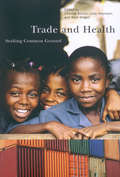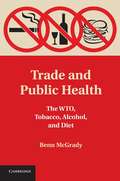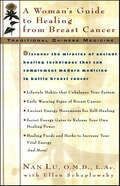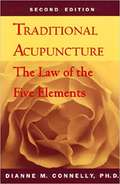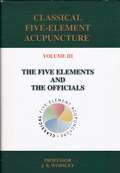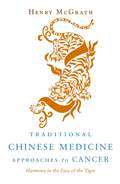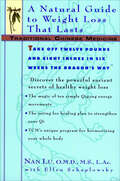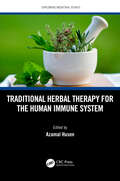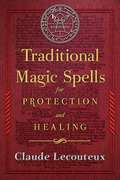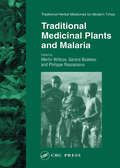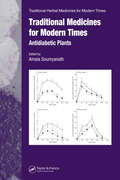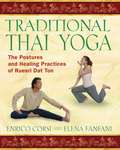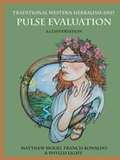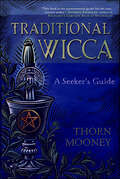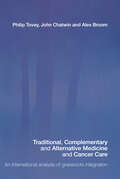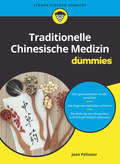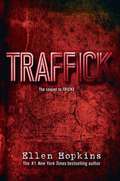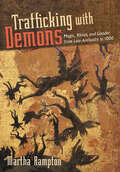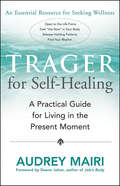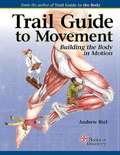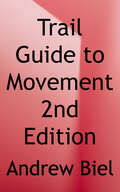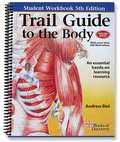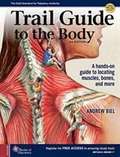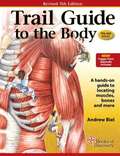- Table View
- List View
Trade and Health: Seeking Common Ground
by Jody Heymann Nick Drager Chantal BlouinSeeking improved health and increased income have long been common goals. Those who make the case that free trade will help everyone argue that the growth from increased trade will be shared and will improve people's lives. But they have not answered the fundamental question of how to formulate trade policy to simultaneously achieve growth and benefit health. Trade and Health answers this question by exploring the entire array of avenues through which trade affects health, and examining a number of case studies on how best to achieve policies that integrate health objectives. The contributors represent the full range of stakeholders in the trade-health debate - medical professionals, civil society representatives, academics from a range of disciplines, and negotiators and policy-makers at the national and global levels. Contributors include Bijit Bora (WTO), Rupa Chanda (IIMB), Diana Chigas (Tufts), Carlos Correa (U of Buenos Aires), Eric Dagenais (Industry Canada), Alison Earle (Harvard), David P. Fidler (Indiana), Anabel González (WTO), Ronald Labonte (Ottawa), Cha-aim Pachnee (MOPH-Thailand), Pedro Roffe (UNCTAD-ICTSD), Nancy Ross (McGill), David Sanders (Western Cape), Ted Schrecker (Ottawa), Anna Shea (McGill), Elisabeth Tuerk (UNCTAD), David Vivas-Eugui (ICTSD), Johanna von Braun (ICTSD), and Suwit Wibulpolprasert (MOPH-Thailand).
Trade and Public Health: The WTO, Tobacco, Alcohol, and Diet
by Benn McgradyNon-communicable diseases, associated with risk factors such as tobacco consumption, poor diet and alcohol use, represent a growing health burden around the world. The seriousness of non-communicable diseases is reflected in the adoption of international instruments such as the WHO Framework Convention on Tobacco Control; the WHO Global Strategy on Diet, Physical Activity and Health; and the WHO Global Strategy to Reduce the Harmful Use of Alcohol. In line with these instruments, states are beginning to use measures such as taxes, restrictions on marketing, product regulation and labeling measures for public health purposes. This book examines the extent to which the law of the World Trade Organization restricts domestic implementation of these types of measures. The relationship between international health instruments and the WTO Agreement is examined, as are the WTO covered agreements themselves.
Traditioal Chinese Medicine: A Woman's Guide to Healing From Breast Cancer (Traditional Chinese Medicine)
by Nan Lu Ellen SchaplowskyDiscover The Power Of Ancient WisdomFor centuries , Traditional Chinese Medicine has helped millions of cancer patients in China, specializing in reducing the risk of breast cancer and healing it by identifying and treating its root cause. Chinese medicine offers a broad range of time-tested, natural, safe, self-healing treating that can complement prevailing Western cancer treatments.Traditional Chinese Medicine provides a nine-point healing guide that can be individually customized for women diagnosed with breast cancer; those about to undergo surgery, chemotherapy or radiation; breast cancer survivors who want to prevent recurrence, and any woman looking for serious prevention techniques. With his training, Dr. Nan Lu revives the ancient healing wisdom of traditional Chinese medicine --Early warning signs from your bodyAncient self-healing evergy movementsHealing, strengthening foods and ancient techniques to strengthen you before surgeryHow to manage your health during chemotherapy or radiationWhy and how to create a new Traditional Chinese Medicine lifestyle that addresses the root cause of breast cancer...and much more!
Traditional Acupuncture: The Law Of Five Elements (Second Edition)
by Dianne M. ConnellyAn explanation of the Five Elements (Wood, Fire, Earth, Metal, Water), and their use in the treatment room. Dr. Connelly shows how traditional acupuncture can make a difference, both in our moment-to-moment appreciation of life and in the way we hold life s bigger picture. Includes a description of the examination done before acupuncture treatment, as well as many case examples. Requires no technical knowledge; fine for the general reader interested in acupuncture and health
Traditional Brazilian Black Magic: The Secrets of the Kimbanda Magicians
by Diego de Oxóssi• Explains how Kimbanda&’s presiding deity Eshu embodies both masculine and feminine principles, both god and devil, and thus represents human nature itself with all its vices and virtues • Discusses Kimbanda&’s magical practices, initiation rites, sacred knives, and sacrificial offerings • Details the seven realms and the entities that inhabit and govern each of them Although it has been demonized as a form of Satanic cult, Kimbanda--the tradition of Afro-Brazilian black magic--is a spiritual practice that embraces both the light and dark aspects of life through worship of the entities known as Eshu and Pombajira. Exploring the history and practice of Kimbanda, also known as Quimbanda, Diego de Oxóssi builds a timeline from the emergence of Afro-Brazilian religions in the 17th century when African slaves were first brought to Brazil, through the development of Orisha cults and the formation of Candomblé, Batuque, Macumba, and Umbanda religious practices, to the modern codification of Kimbanda by Mãe Ieda do Ogum in the 1960s. He explains how Kimbanda&’s presiding deity Eshu Mayoral embodies both masculine and feminine principles, both god and devil, and thus represents human nature itself with all its vices and virtues. Discussing the magical practices, initiation rites, and spiritual landscape of Kimbanda, the author explains how there are seven realms, each with nine dominions, and he discusses the entities that inhabit and govern each of them. The author explores spirit possession and Kimbanda&’s sacrificial practices, which are performed in order to honor and obtain the blessing of the entities of the seven realms. He discusses the sacred knives of the practice and the role each plays in it. He also explores the 16 zimba symbols and sigils used to attract the spirits most apt to realizing the magician&’s will as well as traditional enchantment songs to summon and work with those spirits. Offering an accessible guide to Kimbanda, the author shows that this religion of the people is popular because it recognizes the dark and light sides of human morality and provides a way to interact with the deities to produce direct results. DIEGO DE OXÓSSI is a Chief of Kimbanda and Orishas Priest. For more than 20 years he has been researching and presenting courses, lectures, and workshops on pagan and African-Brazilian religions. He writes a weekly column at CoreSpirit.com and is the publisher at Arole Cultural. He lives in São Paulo, Brazil.
Traditional Chinese Acupuncture: Meridians and Points
by J. R. WorsleyDescribing the principles of Five-Element Acupuncture. Volume Three is about the Elements, in nature and the Officials, which bear the names of the organs of the body.
Traditional Chinese Medicine Approaches to Cancer: Harmony in the Face of the Tiger
by Henry McgrathResearch shows that Chinese medicine can be very effective in supporting the treatment of cancer by orthodox Western methods, and is particularly effective in alleviating many of the side effects of treatment. Henry McGrath draws on his many years as a practitioner of Traditional Chinese Medicine to explain how Chinese medicine approaches cancer in terms of understanding and treatment. He presents the wide range of approaches that Chinese medicine has to offer people with cancer, and offers practical strategies to promote the health of the body as well as methods with which to cultivate the mind, helping the patient develop both physical and mental wellbeing. He covers a wide range of treatments, from acupuncture to Qigong, giving readers a sound basis on which to explore further specific treatment. Traditional Chinese Medicine Approaches to Cancer will be an invaluable book for people with cancer and the medical professionals who work with them.
Traditional Chinese Medicine: A Natural Guide to Weight Loss That Lasts
by Nan Lu Ellen SchaplowskyThe Dragon's WayTo Natural, Healthy, Lasting Weight LossHere at last is the secret to taking off pounds and inches and keeping them off for life. Unlike popular "miracle" diet programs and products, The Dragon's Way addresses the root cause of your weight problems and offers a remarkable six-week program that shows you how to reach your optimum weight and stay there. The Dragon's Way is based on Traditional Chinese Medicine (TCM) theories that have been practiced for thousands of years. Today billions of people worldwide benefit from this medical system. The Dragon's Way is not about food restrictions, apetite suppression, or vigorous exercising. It's about treating the whole person instead of focusing on weight; about how to use ancient energy movements to awaken your healing ability; about showing you how to use food as a healing tool; and about helping you achieve the harmony and balance in your own body that can result in natural, healthy, permanent weight loss.Discover:How the Traditional Chinese Medicine approach differs from diet programsHow this TCM program makes you feel better physically and emotionallyHow stress causes weight problemsHow food cravings signal body needsWhy depriving your body of food leads to further weight gainHealing foods and recipes that help you eliminate excess water and body fatHerbal supplements and energy movements that encourage body harmony and help you avoid excess wieghtAdditional health benefits beyond wieght lossAnd Much More!
Traditional Herbal Therapy for the Human Immune System (Exploring Medicinal Plants)
by Azamal HusenDrawing on indigenous and scientific knowledge of medicinal plants, Traditional Herbal Therapy for the Human Immune System presents the protective and therapeutic potential of plant-based drinks, supplements, nutraceuticals, synergy food, superfoods, and other products. Medicinal plants and their products can affect the immune system and act as immunomodulators. Medicinal plants are popularly used in folk medicine to accelerate the human immune defence and improve body reactions against infectious or exogenous injuries, as well as to suppress the abnormal immune response occurring in immune disorders. This book explains how medicinal plants can act as a source of vitamins and improve body functions such as enhanced oxygen circulation, maintained blood pressure and improved mood. It also outlines how specific properties of certain plants can help boost the immune system of humans with cancer, HIV, and COVID-19. Key features: Provides specific information on how to accelerate and or fortify the human immune system by using medicinal plants. Presents scientific understanding of herbs, shrubs, climbers and trees and their potential uses in conventional and herbal medicine systems. Discusses the specific role of herbal plants that act as antiviral and antibacterial agents and offer boosted immunity for cancer, H1N1 virus, relieving swine flu, HIV and COVID-19 patients. Part of the Exploring Medicinal Plants series, this book is useful for researchers and students, as well as policy makers and people working in industry, who have an interest in plant-derived medications.
Traditional Magic Spells for Protection and Healing
by Claude LecouteuxAn in-depth collection of ancient spells and magic practices drawn from rare and newly discovered texts • Presents more than 600 magical prescriptions for healing and protection from both pagan and Christian sources • Examines the practice of diagnosing illness through magic and explores ancient beliefs about curses and other evil spells and about devils, demons, and ghosts • Includes spells from the heavily guarded gypsy tradition of magic and healing, drawn from newly discovered materials Since the beginning of history, people have sought remedies for the many ills that have beset them, from illnesses afflicting the body to threats posed by evil and hostile individuals. In many folk healing and pagan traditions, it was believed that one must gain the assistance of the guardian spirit of a healing plant or substance through prayers or offerings before its chemical properties would be effective. The Church decried these spells and practices as pagan superstition but did not seek to exterminate these beliefs, instead transferring the responsibility for their healing powers to the apostles and saints. Drawing on his extensive knowledge of ancient texts, Claude Lecouteux presents more than 600 magical prescriptions from both pagan and Christian sources from the last 2,000 years, covering everything from abscesses and shingles to curses and healing animals. He examines the practice of diagnosing illness through magic and looks at the origins of disease according to the evolving beliefs of magic practitioners over the centuries. He explores ancient beliefs about curses and about devils, demons, and ghosts and provides an in-depth look at protection magic, including protection of health, animals, and cultivated land, protection against curses, witchcraft, bad weather, and beasts, protection of a home, and protection while traveling. He includes spells from the heavily guarded gypsy tradition of magic and healing, drawn from newly discovered materials collected by two Romanian ethnologists who lived and traveled with gypsies in Transylvania in the mid-19th century. The author also reproduces rare texts on magic healing from the 14th and 15th centuries. Revealing the vitality of these practices in the remoter areas of Eastern Europe, Lecouteux shows how the influence of this pagan worldview is still detectable in the work of modern folk healers in France and Scandinavia. He also shows how the condemnation of unorthodox methods of healing has not vanished from the contemporary world: the medieval legislation against healing by wizards and bonesetters is echoed in modern health codes that challenge the authority of naturopaths and faith healers.
Traditional Medicinal Plants and Malaria (Traditional Herbal Medicines for Modern Times #4)
by Merlin Willcox; Gerard Bodeker; Philippe RasoanaivoMalaria is an increasing worldwide threat, with more than three hundred million infections and one million deaths every year. The worlds poorest are the worst affected, and many treat themselves with traditional herbal medicines. These are often more available and affordable, and sometimes are perceived as more effective than conventional antimala
Traditional Medicines for Modern Times: Antidiabetic Plants (Traditional Herbal Medicines for Modern Times)
by Amala SoumyanathThe increasing prevalence of diabetes mellitus world-wide is an issue of major socio-economic concern. Scientific interest in plant-derived medicine is steadily rising, yet there is often a wide disparity in the caliber of information available. A detailed compilation of scientific information from across the globe, Traditional Medicines for Modern
Traditional Thai Yoga: The Postures and Healing Practices of Ruesri Dat Ton
by Elena Fanfani Enrico CorsiA complete guide to the ancient technique of Ruesri Dat Ton, also known as Thai yoga • Presents 60 step-by-step, illustrated exercises for self-healing and balanced well-being • Reveals the practice and evolution of Thai yoga, said to have originated with Buddha’s physician, Jivaka Kumarabhaccha • Explains how the postures allow individuals to rebalance the flow of energy in the body Traditional Thai yoga--or Ruesri Dat Ton--is an individual yoga practice rooted in the ancient Ayurvedic tradition. It is comprised of exercises that--like the partnered practice of traditional Thai massage--originated with Buddha’s own physician, Jivaka Kumarabhaccha. Enrico Corsi and Elena Fanfani present, for the first time in English, 60 of these postures fully illustrated with step-by-step instructions designed to stimulate self-healing by rebalancing the flow of energy in the body.Each of the postures works within the sen energy system that underlies Thai medicine. Fundamental to the practice is retention of the breath once the body has assumed the desired posture. The practitioner concentrates the breath on the place where the body is storing tension or dysfunction. When the breath is exhaled the body also expels the negative energy, allowing restorative energy to take its place.The simple yet highly effective postures in Traditional Thai Yoga address many common ailments--including physical ailments of the back, knees, shoulders, hips, arms, feet, and neck and more generalized ailments such as nausea and shortness of breath--as well as offering exercises that promote weight loss, longevity, and overall balanced well-being.
Traditional Western Herbalism and Pulse Evaluation: A Conversation
by Matthew Wood Phyllis D. Light Francis Bonaldo BegnochePulse Evaluation is a pacesetter in the field of herbal and holistic medicine. It sheds new light on herbalism, holistic evaluation, and the age-old art of pulse-reading. "This is a monumental work, and an amazing contribution to our literature. I am always and adamantly of the mind that one's personal experience is of paramount importance, so there was a lot that I would not dream of contesting in your work. As you rightly state, nothing means anything divorced from the context of the patient's whole gestalt. There are many qualities you describe that I will be looking for in the future, or have felt and will reconsider the interpretation. Time will confirm or correct the three of you as the conversation unfolds. I am very pleased to meet Dr. Floyer and invite others to do the same." Brandt Stickley, L. Ac. Assistant Professor of Classical Chinese Medicine, National College of Naturopathic Medicine
Traditional Wicca: A Seeker's Guide
by Thorn MooneyA Down-to-Earth Guide to Traditional WiccaWhile there are many powerful variations of contemporary Witchcraft, traditional Wicca offers unique experiences for those who seek it out. This book explores structured, coven-based styles of Wicca, in which the practitioners typically trace initiatory lineages back to Wicca's early founders. Discussing covens, initiations, lineages, practices, ethics, and more, Traditional Wicca shares tips and ideas on how to get the most from this profound approach to Witchcraft.Discover how to recognize healthy, reputable covens. Learn how to navigate the process of asking for training and succeeding in an outer court. Explore the spiritual strength of lineages, hierarchies, and initiation. This book also includes contributions from several practitioners, providing valuable first-person perspectives on what it's like to be on the traditional Wiccan path.Praise :"Like the bristles of a besom, Thorn Mooney's Traditional Wicca sweeps through the subject of Witchcraft removing the dust and dirt of ignorance and prejudice to reveal the true heart of Wicca. Thorn writes with obvious sincerity, with feeling, and from experience. Her book covers everything from defining Witchcraft, through the workings of a coven, to actual initiation and beyond. She warns that Wicca is not for everyone and—I am personally delighted to see—includes a chapter on recognizing 'Red Flags' when first contacting others...especially those who might claim to be more than they actually are. This book is the quintessential guide for the true, sincere seeker."—Raymond Buckland, author of Buckland's Complete Book of Witchcraft"Traditional Wicca is a unique and important book. It's amazing to me that in over 70 years of publishing on the subject of Wicca, nothing like this book has ever been written! I'm kind of jealous I didn't think to write it myself. The chapter on initiation is, by itself, worth the cover price. If you want to understand what people mean by 'traditional Wicca,' whether or not you're seeking it, this is the one book you must read."—Deborah Lipp, Wiccan high priestess and author of Merry Meet Again"Traditional Wicca is a topic that few actually understand despite its long and distinguished history. With passion and skill, Thorn delivers a book that many familiar with Wicca will wish they had had when they were studying it, and those who find themselves on the path for the first time will rejoice at having found. Whether you intend to seek initiation or not, this book is full of valuable gems that will enhance any practice at any level. Traditional Wicca is an all-inclusive tour through the history, practices, and lore of traditional Wicca that weaves voices from all over the tradition and challenges everything you think you know about it."—Devin Hunter, author of The Witch's Book of Power"A masterful gem of insight and wisdom,Traditional Wicca reveals the time-honored practices of initiatory Wicca, thought all but lost by many, but hidden like so many occult secrets in plain sight. Drawing a clear and respectful distinction between eclectic Wicca and its older more traditional sibling, Thorn Mooney takes us on a personal journey exploring the powers and the pitfalls of the initiatory inner court, revealing the persistence of a thriving and dynamic Craft that is at once orthopraxic and changing, traditional and experimental. With practical advice for the seeker, peppered with personal anecdotes from several practitioners and initiates alike, this book is a much-needed map...Highly recommended."—Storm Faerywolf, author of Betwixt and Between
Traditional, Complementary and Alternative Medicine and Cancer Care: An International Analysis of Grassroots Integration
by John Chatwin Alex Broom Philip ToveyDrawing on comparative fieldwork in the UK, Pakistan and Australia, this book provides the first systematic assessment of pathways and access to CAM and how it is used in health practice and by individuals with cancer. Giving fresh and invaluable insights into how differing health and societal structures influence the use complementary and alternative medicine, the book explores: the empirical, theoretical, and policy context for the study of CAM/TM and cancer the history and character of the eight support groups in which fieldwork took place in the UK, Australia and Pakistan the nature and structure of patient support groups' history, affiliation and evolution how groups function on a day-to-day basis the extent to which what is being offered in these CAM-oriented groups is in any way innovative and challenging to the therapeutic and organisational mainstream the value of sociological work in the field which is not tied to immediate and narrow policy objectives. This is an essential resource for those studying complementary and alternative medicine sociologically, to those involved in the provision of cancer care on a day-to-day basis, and to those looking to establish a more informed (evidence-based) policy.
Traditionelle Chinesische Medizin für Dummies (Für Dummies)
by Jean PelissierWenn die Schulmedizin an ihre Grenzen stößt, kommen alternative Heilverfahren ins Spiel. Hier nimmt die Traditionelle Chinesische Medizin eine besondere Rolle ein. Jean Pélissier stellt die wichtigsten Aspekte der TCM fachlich fundiert und leicht verständlich dar. Er erläutert das Zusammenspiel von Yin und Yang und deren Einfluss auf die Lebensenergie Qi und zeigt die ganzheitliche Sichtweise der TCM auf Gesundheit, Krankheit und den menschlichen Körper. Sie lernen die fünf therapeutischen Säulen, auf denen die TCM beruht - Kräutermedizin, Bewegungsübungen, Massage, Ernährung und vor allem Akupunktur - und die zahlreichen Anwendungsgebiete kennen - von der Behandlung von chronischen Schmerzen, Allergien oder Stresserkrankungen über Atemwegserkrankungen bis zur Nikotinentwöhnung.
Traffick
by Ellen HopkinsFive teens victimized by sex trafficking try to find their way to a new life in this &“sincere and moving&” (Booklist) companion to the #1 New York Times bestselling Tricks from Ellen Hopkins, author of Crank.In her bestselling novel, Tricks, Ellen Hopkins introduced us to five memorable characters tackling these enormous questions: Eden, the preacher’s daughter who turns tricks in Vegas and is helped into a child prostitution rescue; Seth, the gay farm boy disowned by his father who finds himself without money or resources other than his own body; Whitney, the privileged kid coaxed into the life by a pimp and whose dreams are ruined in a heroin haze; Ginger, who runs away from home with her girlfriend and is arrested for soliciting an undercover cop; and Cody, whose gambling habit forces him into the life, but who is shot and left for dead. And now, in Traffick, these five are faced with the toughest question of all: Is there a way out? How these five teenagers face the aftermath of their decisions and experiences is the soul of this story that exposes the dark, ferocious underbelly of the child trafficking trade. Heartwrenching and hopeful, Traffick takes us on five separate but intertwined journeys through the painful challenges of recovery, rehabilitation, and renewal to forgiveness and love. All the way home.
Trafficking with Demons: Magic, Ritual, and Gender from Late Antiquity to 1000
by Martha RamptonTrafficking with Demons explores how magic was perceived, practiced, and prohibited in western Europe during the first millennium CE. Through the overlapping frameworks of religion, ritual, and gender, Martha Rampton connects early Christian reckonings with pagan magic to later doctrines and dogmas. Challenging established views on the role of women in ritual magic during this period, Rampton provides a new narrative of the ways in which magic was embedded within the foundational assumptions of western European society, informing how people understood the cosmos, divinity, and their own Christian faith.As Rampton shows, throughout the first Christian millennium, magic was thought to play a natural role within the functioning of the universe and existed within a rational cosmos hierarchically arranged according to a "great chain of being." Trafficking with the "demons of the lower air" was the essense of magic. Interactions with those demons occurred both in highly formalistic, ritual settings and on a routine and casual basis. Rampton tracks the competition between pagan magic and Christian belief from the first century CE, when it was fiercest, through the early Middle Ages, as atavistic forms of magic mutated and found sanctuary in the daily habits of the converted peoples and new paganisms entered Europe with their own forms of magic. By the year 1000, she concludes, many forms of magic had been tamed and were, by the reckoning of the elite, essentially ineffective, as were the women who practiced it and the rituals that attended it.
Trager for Self-Healing
by Audrey MairiFind Enlightenment Through Your Physical Body Audrey Mairi views enlightenment not as a philosophical puzzle to solve or a spiritual epiphany but instead as an everyday experience grounded in ordinary physical movements. Designed for all ages and fitness levels, Trager for Self-Healing presents simple ways to increase awareness of the present moment. While many books offer advice about being in the now, few point out practical ways to experience what that actually feels like. The exercises in this book are designed to anchor the feeling of presence in the body/mind. Based on the work of Dr. Milton Trager, this book will guide you to release holding patterns, open to the Life Force, and make healthy choices, bringing love and light into your life.
Trail Guide To Movement: Building The Body In Motion (First Edition)
by Andrew Biel Robin DornJoin author Andrew Biel on a unique and fascinating journey as he helps you build -- step by step -- a human body in motion! Instead of dissecting the body into smaller, isolated pieces, Trail Guide to Movement takes a unique approach of building the body into larger, interconnected components. He asks the reader to join him as an active participant in building the body from scratch. <P><P>The journey in this book begins by designing four key structures for movement: connective tissue, joints, muscles and nerves. Then, after applying some bio-mechanical principles, the reader puts the body to the test by exploring the concepts of posture and gait. <P><P>Trail Guide to Movement is written with the same encouraging voice and subtle humor as the iconic Trail Guide to the Body, making the study of human movement easy to understand, captivating, and memorable.
Trail Guide to Movement: Building the Body in Motion
by Andrew BielThe author explores how bones, fasciae, joints, muscles and other structures come together to produce human movement. Taking the same approach as the acclaimed Trail Guide to the Body, this text makes the study of human movement easy to understand, captivating and memorable. <p><p>Instead of dissecting the body into smaller, isolated pieces, the author takes a unique approach of building the body into larger, interconnected components. The author asks the reader to join him as an active participant in building the body from scratch.
Trail Guide to the Body Student Workbook: An Essential Hands-On Learning Resource
by Andrew BielThe essential companion to the Trail Guide textbook, this workbook asks students to apply the material by answering questions in a variety of formats including fill-in-the-blanks, drawings to color, illustrations and matching exercises. Great for self-testing, homework and preparing for national exams. The Student Workbook helps students stay on track and keep pace with the class.
Trail Guide to the Body: A Hands-On Guide to Locating Muscles, Bones, and More
by Andrew Biel Robin DornThe Trail Guide to the Body is a guidebook for a hands-on journey around the body. The book has seven chapters, six of which focus on different regions of the body. Trail Guide to the Body is designed around the following scenario: You follow along with the text and palpate on a partner (friend or classmate) who is on a bodywork table or seated in a chair. If you are a student, you are advised to proceed step by step, repeat certain methods when necessary, and explore the body along the way. If you are a more experienced practitioner, you may want to pick and choose your destinations.
Trail Guide to the Body: A Hands-on Guide to Locating Muscles, Bones and More
by Andrew BielTrail Guide to the Body, 5th Edition, A hands-on guide to locating muscles, bones and more Before you can assess or treat a muscle, you first must be able to locate it. This acclaimed book delivers beautifully illustrated information for learning palpation and the musculoskeletal system. It makes mastering the essential manual therapy skills interesting, memorable and easy. With 504 pages and 1,400 illustrations covering more than 162 muscles, 206 bones, 33 ligaments and 110 bony landmarks, this text provides an invaluable map of the body. This new edition includes an extensive 56-page appendix that describes the common trigger point locations and pain patterns of 100 muscles. Trail Guide to the Body is a highly recommended textbook for the state licensing tests administered by both the National Certification Board for Therapeutic Massage and Bodywork (NCBTMB) and the Federation of State Massage Therapy Boards (FSMTB) and is one of only five books on their official examination reference lists. In addition, the Board of Certification program for athletic trainers in the U. S. uses our high-quality Trail Guide to the Body illustrations in their various products, including exams. Whether you are a massage therapist, physical therapist, sports trainer or student in any bodywork modality, Trail Guide to the Body is for you!
